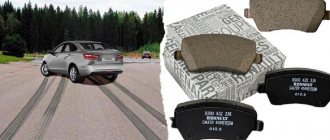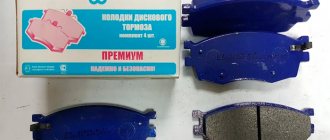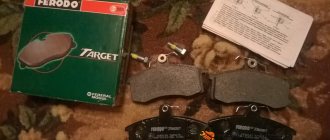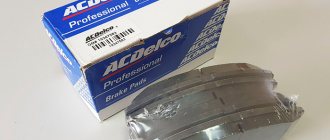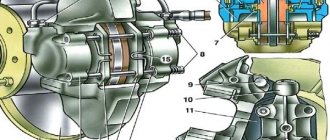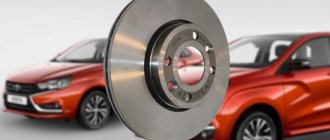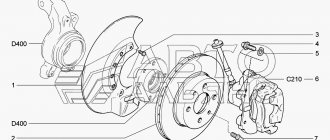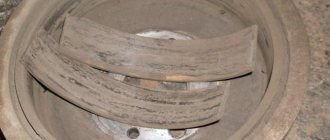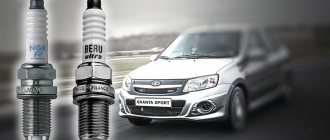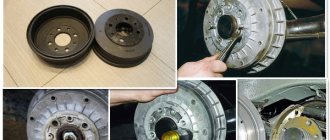The new Vesta from the domestic Lada model range has made a huge breakthrough in the production of Russian passenger cars. You can argue for a long time about the quality of the vehicle, but in the end there will be much more advantages. The car leaves a very good impression while driving; it responds instantly to the brake pedal. Lada Vesta slows down thanks to brake pads installed on the front and rear wheelset.
The brake system is the main component of any car, and the safety of the vehicle depends on its condition. Therefore, it is necessary to monitor the brake pads and replace them on time.
What front brake pads can be installed on Lada Vesta
The front wheels take on more load when braking the car, so the pads have to be changed more often than the rear wheels. The quality of the part material affects the braking performance and the squeaking sound of the wheel.
A car brake pad consists of a metal plate and a lining. It is the quality of the lining material that affects the degree of wear of the product, as well as the coefficient of friction during braking. The car is equipped with Renault front brake pads (catalog number 8200 432 336 TRW).
There are original and non-original pads on the auto parts market.
It has been noted that analogues of the original pads have a significantly shorter service life and efficiency.
This is due to the use of asbestos in the manufacture of the part, which negatively affects the technical characteristics of the pad. Although, there are analogues that are suitable and can serve the car for a long time.
| Manufacturer | vendor code | price, rub. |
| Original | ||
| LADA | 410608481R | 1450 |
| FERODO | FDB1617 | 1650 |
| FORTECH | FB1223F | 864 |
| Analogue | ||
| KOTL | 22KT | 1504 |
| ADR | ADR011311 | 377 |
| Valeo | 301641 | 971 |
Rear pads
Here the user is also offered several options for original and good analogues.
Original
If in the case of the front pads everything is simple, since the originals are easy to find, and their cost is more than adequate, then the original pads for the rear brake drums will cost more than 5,000 rubles, moreover, sometimes they are very difficult to find. The original pads from Vesta have the number 8450076668.
As already mentioned, some versions have disc brakes; in this case, the original ones are pads from TRW under the number GDB1384, they cost about 1,500 rubles.
Moreover, users did not find any significant defects, and they can be found in stock or ordered at almost any spare parts store. Accordingly, in the case of installed rear disc brakes, the most reasonable option would be to use the same pads from TWR that the manufacturer supplied from the factory.
Analogs
If everything is clear with disc brakes, then users of versions with a drum mechanism are extremely dissatisfied with such a high cost of the original brakes, given that the car still represents the public sector class.
Therefore, it is worth paying attention to some proven analogs that will install without problems and do not require modifications; moreover, the above options are of good quality and cost much less than the original:
- BS 5717 from the Japanese brand Lynx;
- BP53168 from Fenox.
Also, many users note that after small and simple modifications, pads from Ford Fusion can be installed on Vesta.
Resource
The pads on discs are usually changed every 20-30 thousand kilometers. In the case of drums, the manufacturer recommends changing the pads every 15 thousand, but most often this period increases, and they are changed at the first sign of wear, for example, extraneous sounds or decreased braking efficiency.
What rear brake pads can be installed on Lada Vesta
| Manufacturer | vendor code | Price, rub. |
| Original | ||
| FORD | 1433865 | 2735 |
| PILENGA | BSP8454 | 1160 |
| ATE | 03.0137-0394.2 | 2510 |
| Unoriginal | ||
| Brembo | P68033 | 1034 |
| FENOX | BP53013 | 663 |
| Amiwa | CD1261 | 787 |
| LYNXauto | BS-5717 | 1355 |
Replacing front pads on Vesta
According to the regulations, it is necessary to inspect brake pads at least once every 15 thousand kilometers. Consumables must be replaced if:
- friction material thickness less than 1.5 mm;
- the friction lining has cracks, scratches or traces of oil on its surface;
- the friction lining peels off from the base;
- The wear on different sides is uneven and unequal in thickness.
Due to its design features, the caliper puts pressure on the center of the pad, and not on its entire area, so the linings wear unevenly over the entire surface and have a wedge-shaped shape. The side with the maximum degree of wear is not visible without removing the pads, so it is recommended to remove them from the calipers and evaluate them more objectively.
The car is placed on a level surface and secured with a parking brake. In the case of removing the rear pads, on the contrary, the handbrake should not hold the car, and its cable should be as loose as possible. Then you need to assess the brake fluid level. If it is normal, you should pump it out to a minimum. Wheel chocks are installed under the rear wheels. Using a wheel wrench, the wheel nuts are loosened and the car is raised on a jack. After the wheel does not touch the ground, the lifting stops, and any reliable stop is installed under the bottom next to the jack, which will serve as insurance in case the lift falls off. The wheel bolts are unscrewed all the way and they are removed.
The hub with the desired disc must be turned outward from under the wheel arch. To do this, turn the steering wheel all the way to the right or left. Using a screwdriver or a flat-end paddle, press the caliper piston all the way in. To do this, you need to insert a screwdriver between the piston and the block from the inside
When doing this, be careful not to damage the rubber boot.
Using a 13 mm wrench, unscrew the bolt securing the bracket to the guide, while at the same time the guide is held in place with another 15 mm wrench.
Next, the bracket is folded together with the brake hose to the side, and the old pads along with the spring brackets are removed from the guide sockets.
The condition of the friction linings is assessed, the caliper mechanism is checked, and, if necessary, a new set of pads is developed and prepared for installation. The brackets and guide sockets are cleaned with a wire brush to remove dirt and rust. The anthers are checked for damage and replaced if necessary. New pads are also inspected and inserted into the socket guides. Next, this unit is assembled in the reverse order, after which you can proceed to replacement on the other side.
Upon completion of all work, you need to press the brake pedal all the way several times until resistance appears, this means that the pistons have taken their place and are in the working position. Then you need to add the brake fluid level to about.
Signs of Worn Pads
Problems in the operation of brake linings can arise as a result of natural abrasion or poor-quality material of the product, leading to rapid wear of the surface of the vehicle pad.
What you should pay attention to in order to prevent the ineffective operation of brake linings in time:
- The appearance of a large lift of the parking brake handle. Normal lifting of the Lada Vesta is determined by 3 or 4 clicks. Another indicator is that on an incline, with the handbrake raised, the car begins to roll downhill. Of course, this could be due to a stretched cable.
- On Vesta with increased comfort, electronic sensors are installed that signal a critical level of pad wear.
- A sharp decrease in brake fluid level.
- The brake pedal begins to gradually sink.
- When braking, the car skids to one side.
- During the operation of the vehicle, the braking distance begins to change upward.
Reviews
| № | Positive |
| 1. | Valery , 43 years old (www.otzovik.com): driven over 75,000 km, TRW pads installed. I'm happy with the quality, no complaints. |
| 2. | Kirill , 39 years old (www.zr.ru): I’ve been actively using the car for two years now, without any comments. The units are operating normally. |
| 3. | Vitaly , 23 years old (www.autobann.su): original pads installed on Lada Vesta from Renault. The quality is impeccable, the pedal moves smoothly, and the car does not pull to the side. |
| 4. | Georgy , 33 years old (www.lada-vesta.net): I bought the car second-hand, the Lada Vesta already had Ferodo pads installed. More effective than the native ones, which are equipped by default. |
| 5. | Vladlen , 41 years old (www.otzovik.com): there are no comments on the brake circuit, unlike the Lada Grant, the Vesta has good brakes. |
| 6. | Dmitry , 43 years old (www.zr.ru): on the advice of his comrades, I bought ATE pads. I've been testing it for a month, no comments. |
| 7. | Vitalievich , 25 years old (www.autobann.su): I recommend Eurodetal pads to all my friends. Good quality, affordable price, manufacturer's warranty.. |
| 8. | Zheka , 33 years old (www.lada-vesta.net): calipers, linings are good, mileage over 45,000 km, sufficient thickness reserve. |
| 9. | Konstantin Vladislavovich , 49 years old (www.otzovik.com): replaced the original linings at a mileage of 70,000 km, for a domestic car this is very good. |
| 10. | Makarovich , 43 years old (www.zr.ru): the car is of average quality, in some places it needs improvement. |
| 11. | Vasily , 36 years old (www.autobann.su): review of the car is positive, the driver must have systematic care and prevention. |
| Negative | |
| 12. | Ivan , 42 years old (www.zr.ru): the original linings lasted a year, after which they wore out. As it turned out at the service station, it was a manufacturing defect; it was replaced under warranty. |
| 13. | Vitaly , 38 years old (www.otzovik.com): the car is good, but the quality of the parts was inherited. |
| 14. | Ivan Vasilyevich , 47 years old (www.autobann.su): if possible, buy a second generation Renault Megane, Renault Logan, Duster. |
Related link:
How to properly remove the front and rear bumper on a Lada Vesta
Types of brake pads
There are four main types of brake pads, and it's important to know what type your car comes with so you can find the right replacement. Remember to consult a specialist if you are unsure
- Semi-metallic. Containing 35-65% metal, semi-metallic brake pads are very durable and provide exceptional heat transfer. However, they can also be noisy, cause rotor damage, and tend to be less efficient in cold weather.
- Organic. Made from fibrous materials such as rubber, carbon or glass, these gaskets are quieter than semi-metallic ones. Because they are softer, they tend to wear out faster and create more dust.
- Low metal. They are typically made from an organic formula with a small amount of metals - such as steel or copper - for improved heat transfer and braking speed. These pads work effectively, but the more metal in the formula, the more noise and dust.
- Ceramics. Probably the most effective brake pads are made primarily of ceramic fibers. They are generally quiet and clean with minimal damage to the rotors. The downside is inevitably that they are more expensive.
In some cases, it may be possible to install a higher quality brake pad. However, be sure to consult an expert to ensure it will fit your vehicle.
The procedure for replacing parts is as follows:
- Secure the vehicle in place by applying the parking brake. Turn off the ignition. Raise the front of Vesta with a jack;
- Proceed to remove the wheel. Remove the cap, loosen the bolts one turn. Continue this action in a circle with all the bolts;
- Remove the brake fluid reservoir cap and pump out a few milliliters. This will prevent the liquid from coming under pressure. Press the brake cylinder inward with a screwdriver;
- Use a 15mm wrench to hold the caliper guide pin, and use a 13mm wrench to remove the two bolts. Do not let the free part of the caliper fall to the ground;
- Pry up the outer pad with a screwdriver and carefully remove it. In the same way, remove the inner block;
- The spring retainer, which is responsible for uniform wear, will have to be cleaned and then re-coated with lubricant;
- Install a new part - first the external one, then the internal one;
- Clean the guides and also coat them with lubricant;
- Put all the parts back;
- Tighten the fastening bolts, install the wheel, clockwise, one rotation at a time, secure all the bolts.
New Lada: What oil to pour into Lada Granta 8 valves
Analogues on calipers and drums
There are analogues for Lada Vesta drum brakes on the market:
- Fenox (BP53013). Cost 980 rubles; (BP53168) Price 1340 rubles;
- Hella Pagid (8DB355002-411). Price 2780 rubles;
- JP Group (1563900810). Price 1490 rubles;
- Mintex (MFR516). Price 2550 rubles;
- Patron (PSP8742). Price 730 rubles;
- Remsa (4137.00). Price 1110 rubles;
- Textar (91057300). Price 3130 rubles.
There is an analogue of Lada Vesta disc brakes. It is produced by TRW, article number gdb1384, cost – 1400 rubles.
The nature of the malfunctions can be noted:
- Uniform wear - it manifests itself in the fact that the friction layer is worn evenly, this shows that the brakes are working well.
- Severe wear of the friction layer, brake rivets are visible - this means that you have been using the “outdated” parts for too long. The rivets could damage the disc, so it would be a good idea to inspect it for damage.
- The friction layer is worn evenly around the entire circle, but one of the sides is worn out more than the other - one of the parts of the brake system (guide or piston) does not distribute the braking force correctly. Cleaning all “live” parts and applying a new layer of lubricant will help. Naturally, everything will have to change.
- Both components are worn unevenly, the surface is strewn with irregularities and roughness. The reason for this outcome is a malfunction of the caliper guide pins - they swing and do not give an even trajectory of movement. You will have to clean them, then reapply lubricant.
- The friction lining is cracked - in this case, the “trouble” is caused by the brake discs themselves - they wear unevenly. Everything will have to change.
- Uneven wear of the friction layer means that the parts were installed incorrectly. They will have to be changed.
After performing a visual inspection of the damage, you can independently make a verdict about the breakdown. And besides this, there are several other signs by which you can find out about a faulty front pad while sitting behind the wheel.
New Lada: Vesta Cross VS Lada XRAY: an unbiased comparison of the flagships of the domestic automotive industry
